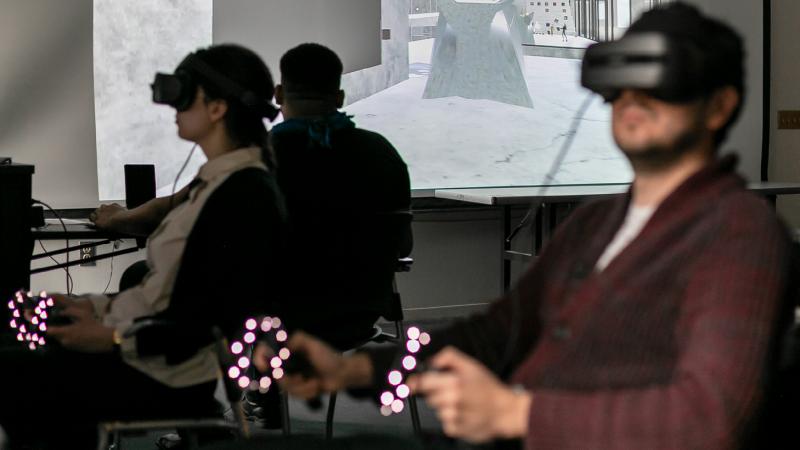Alternative Dimensions: Explorations in Virtual and Augmented Reality
Inside Knowlton Hall, critics and students were invited to don a headset and enter another Knowlton Hall—this one a virtual space complete with identical walls, floors, ceilings and windows, but simulating an architecture unbound by the laws of physics. This virtual reality (VR) experience, where visitors moved through the space and interacted as avatars, was the culmination of graduate architecture student John Fleming’s Master Project.
“I wanted to explore the ways in which architecture can exercise agency in a virtual world that are impossible in physical reality. When we view VR only as a representational tool, we accept the rules and limitations of physical reality,” commented Fleming. “My project asks what is possible when architecture is designed for a virtual world.”

To explore this altered relationship between individuals and the built environment, Fleming occupied his virtual Knowlton Hall as WallGuy, an avatar that allowed him to make a body that is also architecture. As WallGuy, Fleming created a figure whose shape could transform and function as an enclosure that other avatars could experience as a room while at the same time have a conversation with him as a person.
Learning to project oneself into the space of an architectural project has always been one of the core goals of an architecture and landscape architecture education. Through orthographic plans, sections and three-dimensional representations, students are trained to imaginatively occupy their design space. Virtual reality now allows this projection—and its attendant perspectival experiences—to simulate movement through a design environment, enriching one’s understanding of how a space feels and operates.
As VR moves beyond its novelty stage as a tool for representation, speculative design and spatial possibilities open into entirely new dimensions at the Knowlton School. Advances in augmented reality (AR) with new applications such as Augment, which transforms a plan into a 3D model hologram, or WalkingApp, whose add-ons enable Autodesk Revit and Fusion 360 users to turn their 3D designs into augmented and virtual reality, will impact and accelerate innovation in design and modeling.
Graduate landscape architecture student Claire Brewer envisioned a swaying forest of trees through the corridors of Knowlton Hall. For her Independent Study project under the instruction of Associate Professor of Landscape Architecture Jake Boswell, Brewer worked with a program called Unity to build out a forest-simulating mobile device app.
“I began with setting an image on a physical space, in this case an “X” on the floor, and then tethered a digital model of trees onto that space,” commented Brewer, explaining how she created her augmented reality simulation. “If you point your mobile device at the “X” on the floor, the app recognizes this image, and the digital trees appear within the scene your phone or tablet is viewing.”

Brewer’s project launched during FORESTED, the inaugural Projecting Landscapes event and exhibition sponsored by the Landscape Architecture Section. During the Augmented Ecologies: The Hunt for Forests workshop, students roamed the ramps and hallways of Knowlton Hall with their mobile devices to discover groves of maple trees or a huddle of conifers billowing up to the ceilings.
“It allows us to bring what we’ve been doing for a really long time with digital modeling and 2D and 3D graphics, which are static, and add elements of the environment to them—wind, sunlight, rain, fog, snow—to create environments that are responsive,” commented Boswell on the possibilities for visualizing and designing landscapes with immersive and interactive digital elements. “Unity allows us to inhabit these spaces we’re making in a way we couldn’t before.”
Boswell speculates that in two or three years a landscape architect will be able to communicate with a client beyond just showing them drawings. “We will be able to provide a walk-thru that allows them to experience their space at different times of the day and in different climatic conditions,” added Boswell.
“If I were asked the applicability of this technology to architecture, I would respond that I am proposing, or rather predicting, a new form of practice,” stated Fleming. He pointed specifically to the entertainment and gaming industries as a point of entry for this new branch of design. “Software engineers are now designing the built environment in these virtual spaces. I think the discipline of architecture can stake its claim as the expert field for understanding the effects of the built environment on people, and how these spaces can be optimally designed.”


